
Wetenschap
Eenvoudig proces haalt waardevol magnesiumzout uit zeewater
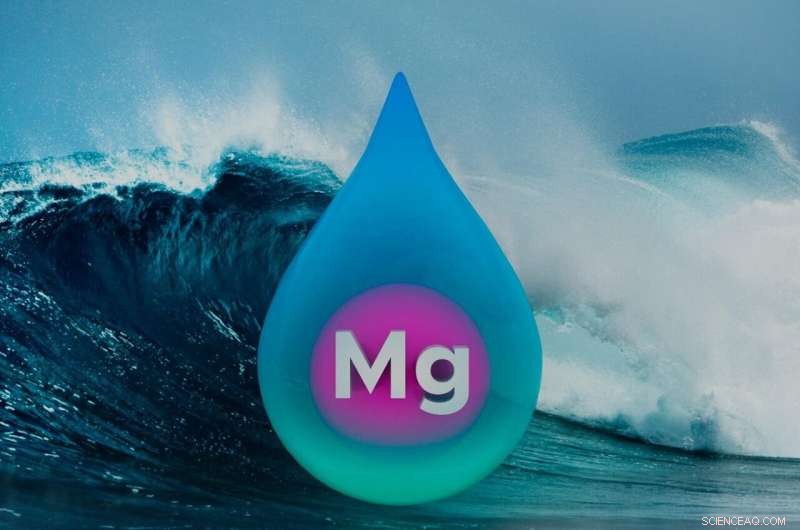
Onderzoekers kunnen magnesiumgrondstoffen isoleren uit de oceaan, belangrijk voor toepassingen op het gebied van hernieuwbare energie. Credit:Samengesteld beeld door Cortland Johnson, Pacific Northwest National Laboratory
Sinds de oudheid hebben mensen zouten, zoals tafelzout, uit de oceaan gewonnen. Hoewel tafelzout het gemakkelijkst te verkrijgen is, is zeewater een rijke bron van verschillende mineralen, en onderzoekers onderzoeken welke ze uit de oceaan kunnen halen. Een zo'n mineraal, magnesium, is overvloedig aanwezig in de zee en wordt steeds nuttiger op het land.
Magnesium heeft opkomende duurzaamheidsgerelateerde toepassingen, waaronder in koolstofafvang, koolstofarm cement en potentiële batterijen van de volgende generatie. Deze toepassingen brengen hernieuwde aandacht voor de binnenlandse magnesiumproductie. Momenteel wordt magnesium in de Verenigde Staten gewonnen via een energie-intensief proces uit pekel uit zoutmeren, waarvan sommige gevaar lopen door droogte. Het ministerie van Energie heeft magnesium opgenomen op de onlangs vrijgegeven lijst van kritische materialen voor binnenlandse productie.
Een paper gepubliceerd in Environmental Science &Technology Letters laat zien hoe onderzoekers van Pacific Northwest National Laboratory (PNNL) en de University of Washington (UW) een eenvoudige manier hebben gevonden om een puur magnesiumzout, een grondstof voor magnesiummetaal, uit zeewater te isoleren. Hun nieuwe methode laat twee oplossingen naast elkaar stromen in een lange stroom. Dit proces, dat de laminaire coflow-methode wordt genoemd, maakt gebruik van het feit dat de stromende oplossingen een constant reagerende grens creëren. Verse oplossingen stromen voorbij, waardoor het systeem nooit een evenwicht kan bereiken.
Deze methode speelt een nieuwe truc met een oud proces. Halverwege de 20 e eeuw creëerden chemische bedrijven met succes magnesiumgrondstoffen uit zeewater door het te mengen met natriumhydroxide, beter bekend als loog. Het resulterende magnesiumhydroxidezout, dat de antacidummelk van magnesia zijn naam geeft, werd vervolgens verwerkt om magnesiummetaal te maken. Het proces resulteert echter in een complex mengsel van magnesium- en calciumzouten, die moeilijk en kostbaar te scheiden zijn. Dit recente werk produceert puur magnesiumzout, wat een efficiëntere verwerking mogelijk maakt.
"Normaal gesproken brengen mensen het scheidingsonderzoek vooruit door meer gecompliceerde materialen te ontwikkelen", zegt PNNL-chemicus en UW-filiaalhoogleraar Materials Science and Engineering Chinmayee Subban. "Dit werk is zo opwindend omdat we een heel andere aanpak hanteren. We hebben een eenvoudig proces gevonden dat werkt. Als het wordt opgeschaald, kan dit proces de wedergeboorte van de Amerikaanse magnesiumproductie helpen stimuleren door primaire grondstof te genereren. We zijn omringd door een enorme , blauwe, onaangeboorde bron."
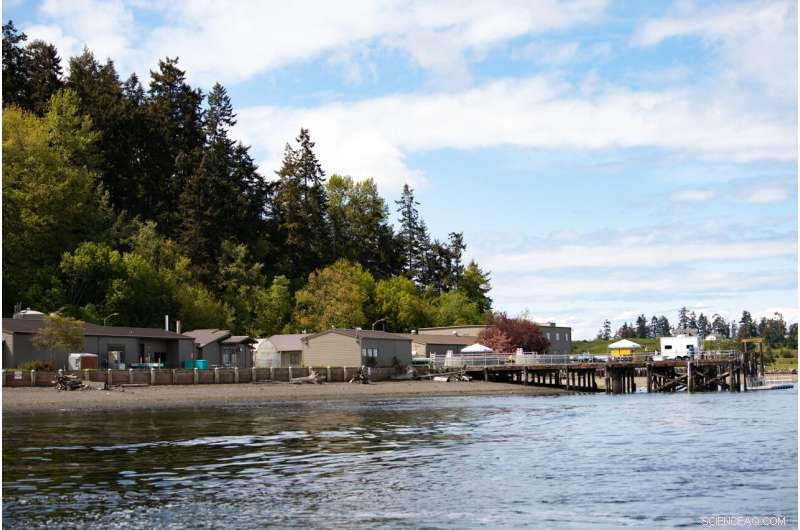
Zeewater van de PNNL-Sequim-campus voedde dit onderzoeksproject. Krediet:Andrea Starr, Pacific Northwest National Laboratory
Van Sequim-water tot vast zout
Subban en het team testten hun nieuwe methode met zeewater van de PNNL-Sequim-campus, waardoor de onderzoekers konden profiteren van de PNNL-faciliteiten in de staat Washington.
"As a Coastal Sciences staff member, I just called a member of our Sequim chemistry team and requested a seawater sample," said Subban. "The next day, we had a cooler delivered to our lab in Seattle. Inside, we found cold packs and a bottle of chilled Sequim seawater." This work represents the collaboration that can happen across PNNL's Richland, Seattle, and Sequim campuses.
In the laminar coflow method, the researchers flow seawater alongside a solution with hydroxide. The magnesium-containing seawater quickly reacts to form a layer of solid magnesium hydroxide. This thin layer acts as a barrier to solution mixing.
"The flow process produces dramatically different results than simple solution mixing," said PNNL postdoctoral researcher Qingpu Wang. "The initial solid magnesium hydroxide barrier prevents calcium from interacting with the hydroxide. We can selectively produce pure solid magnesium hydroxide without needing additional purification steps."
The selectivity of this process makes it particularly powerful. Generating pure magnesium hydroxide, without any calcium contamination, allows researchers to skip energy-intensive and expensive purification steps.
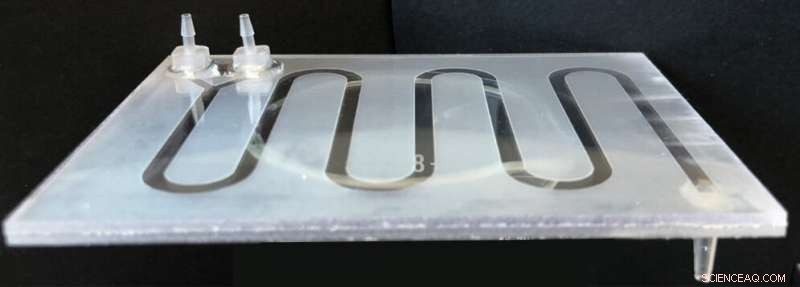
The laboratory-scale flow device for extracting magnesium salt. Credit:Qingpu Wang, Pacific Northwest National Laboratory
Sustainability for the future
The new and gentle process has the potential to be highly sustainable. For example, the sodium hydroxide used to extract the magnesium salt can be generated on site using seawater and marine renewable energy. Removing magnesium is a necessary pre-treatment for seawater desalination. Coupling the new process with existing technologies could make it easier and cheaper to turn seawater into freshwater.
The team is particularly excited about the future of the process. Their work is the first demonstration of the laminar coflow method for selective separations. This new approach has many additional potential applications, but more work needs to be done to understand the underlying chemistry of the process. The knowledge gap offers new possibilities and research directions for powering the blue economy.
"We want to take this work from the empirical to the predictive," said PNNL materials scientist Elias Nakouzi. "There is an exciting opportunity to develop a fundamental understanding of how this process operates while applying it to important problems like creating new energy materials and achieving selective separation of hard-to-separate ions for water treatment and resource recovery." + Verder verkennen
Extracting high-quality magnesium sulphate from seawater desalination brine
 Onderzoekers breken plastic afval af
Onderzoekers breken plastic afval af Belangrijkste mechanismen van luchtwegontspanning bij astma onthuld in nieuwe studie
Belangrijkste mechanismen van luchtwegontspanning bij astma onthuld in nieuwe studie Wetenschappers vinden lichtgewicht vloeibare metalen materialen uit
Wetenschappers vinden lichtgewicht vloeibare metalen materialen uit Semi-flexibele modelgebaseerde analyse van celadhesie aan hydrogels
Semi-flexibele modelgebaseerde analyse van celadhesie aan hydrogels Spinnen en mieren inspireren metaal dat niet zinkt
Spinnen en mieren inspireren metaal dat niet zinkt
 Piramide pakt gezondheids- en klimaateffecten van voedsel aan
Piramide pakt gezondheids- en klimaateffecten van voedsel aan Het veel voorkomende insecticide dat onze rivieren en wetlands vergiftigt
Het veel voorkomende insecticide dat onze rivieren en wetlands vergiftigt Aanhoudende droogte leidt tot grote voedselzekerheidscrisis in Somalië
Aanhoudende droogte leidt tot grote voedselzekerheidscrisis in Somalië Verhoogde beschikbaarheid van water door klimaatverandering kan meer voedingsstoffen in de bodem op Antarctica vrijgeven
Verhoogde beschikbaarheid van water door klimaatverandering kan meer voedingsstoffen in de bodem op Antarctica vrijgeven NASA ziet tropische cycloon Debbie aan land komen in Queensland
NASA ziet tropische cycloon Debbie aan land komen in Queensland
Hoofdlijnen
- Human Heart Science Projects
- Uit onderzoek blijkt dat bedwantsen potentieel gevaarlijke hoeveelheden histamine produceren
- Een keep-fit gadget voor uw hond deze kerst - wie heeft er echt baat bij?
- Overlevingsstrategie van boodschapper-RNA's tijdens cellulair suikertekort
- Inzoomen op eiwit om nierstenen te voorkomen
- De juiste manier om DNA te repareren
- Coevolution: definitie, soorten en voorbeelden
- Studie kijkt naar de invloed van woonwerven op voedselwebben
- Wat is Ribonucleic Acid?
- Film-fotosensitizer:zeer efficiënte singlet-zuurstofgeneratie
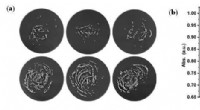
- Fosforescerend materiaal geïnspireerd op glow in the dark hout
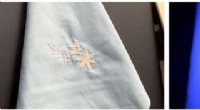
- Genenschaar gebruiken om ziekten op te sporen
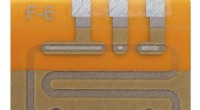
- Een vreemd fenomeen ontrafelen dat zowel de prestaties van lithium-ionbatterijen helpt als schaadt

- Het belang van een periodiek systeem
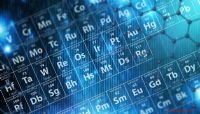
 Een 3D-model maken van de aardlagen zonder Styrofoam
Een 3D-model maken van de aardlagen zonder Styrofoam Vlokkig grafeen maakt betrouwbare chemische sensoren
Vlokkig grafeen maakt betrouwbare chemische sensoren Door sancties getroffen Huawei plant componentenfabriek in Europa
Door sancties getroffen Huawei plant componentenfabriek in Europa Grote steden concentreren minder wetenschappelijke productie
Grote steden concentreren minder wetenschappelijke productie Studie onthult waarom sommigen Aziatische Amerikanen de schuld geven van COVID-19
Studie onthult waarom sommigen Aziatische Amerikanen de schuld geven van COVID-19 VN-rapport:Technologieën kunnen levens helpen, maar vergroten ongelijkheid
VN-rapport:Technologieën kunnen levens helpen, maar vergroten ongelijkheid Het percentage van iets uit een gegevensset berekenen
Het percentage van iets uit een gegevensset berekenen  Een 140 jaar oud geheim in de natuurkunde ontrafelen
Een 140 jaar oud geheim in de natuurkunde ontrafelen
- Elektronica
- Biologie
- Zonsverduistering
- Wiskunde
- French | Italian | Spanish | Portuguese | Swedish | German | Dutch | Danish | Norway |

-
Wetenschap © https://nl.scienceaq.com

